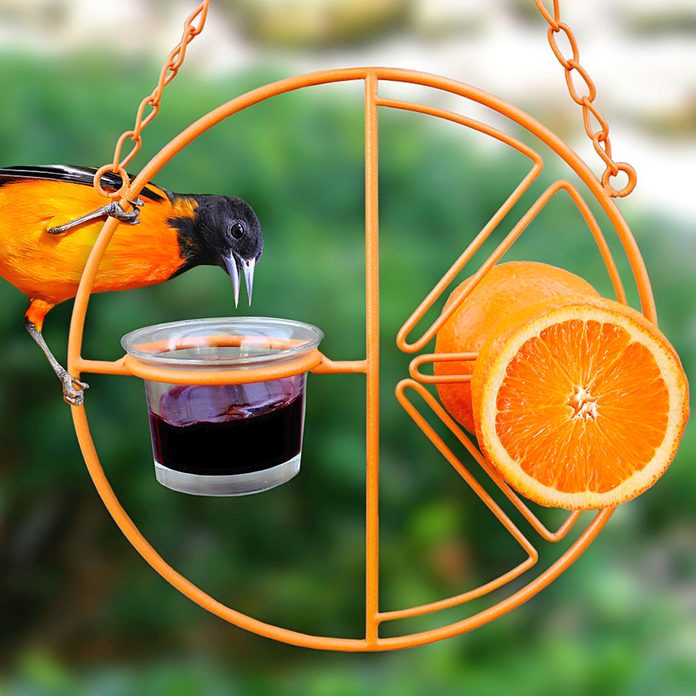How to Identify a Cliff Swallow vs a Barn Swallow

Cliff swallows and barn swallows are both beautiful birds that are commonly confused for each other. Both swallows build mud nests on buildings and bridges. Learn more about swallows’ nests and nesting habits. When perched, both birds show reddish brown throats and steel-blue backs. For more help with telling these similar species apart, use these helpful tips to separate a cliff swallow vs a barn swallow.
Learn about 8 types of swallows found in North America. Plus, learn about the significance of swallow sightings.
Tail Shape

Their tail shape is what separates cliff swallows and barn swallows in flight. The barn swallow has a long forked tail with white spots, while the cliff swallow’s tail is short.
Learn how to identify and attract a tree swallow, and look for violet-green swallows in the west.
Forehead

Another thing to look at is the foreheads on both birds. A cliff swallow’s forehead can be white or brown, but a barn swallow’s forehead is always reddish brown.
Here’s how to identify and attract a purple martin.
Plumage

Finally, check out the coloring. Look for the cliff swallow’s pale buff-colored lower back and rump, and pale collar across the back of the neck. The barn swallow’s back is solidly dark blue, from head to tail.
Next, learn how to tell the difference between a downy vs hairy woodpecker and a house finch vs purple finch.
On This Page
Butterflies and Thistles

Every time I steam an artichoke for supper, I think about butterflies. Our fluttery friends can’t resist thistle flowers. And an artichoke is nothing but a giant thistle. I never even realized I was eating a flower bud until I saw an artichoke in full bloom. The bold, spiny-leafed plant, as tall as me, was a real standout among the softer, mounded perennials. But what really made me drool were all of the butterflies dancing all around the fuzzy flower.
Until I saw that plant, I’d been patting myself on the back for attracting butterflies, but suddenly the dozen or so butterflies on my new patch of purple coneflowers and colorful zinnias didn’t seem as impressive.
My neighbor’s single artichoke plant was surrounded by more butterflies than I’d seen all summer. Monarchs, hairstreaks, painted ladies and other delicate butterflies battled for perching rights on the fat, fuzzy flowers.
Do Butterflies Like Daisies?

Although you’d never guess at first glance, those artichoke blossoms, and nearly all other fuzzy flower varieties that are great for attracting butterflies, are actually daisies—members of the same composite family, Asteraceae, as are my coneflowers and zinnias.
Butterflies love daisies and related flowers, because the center “eye” is an all-you-can-eat meal of tiny florets. Instead of flying from flower to flower, a nectar seeker can just dip its proboscis into one floret after another. But fuzzy flowers are daisies with a difference.

These flowers are packed from edge to edge with thin, soft, tubular florets. Down in those fuzzy flower tubes is sweet nectar, and a butterfly’s long proboscis is tailor-made for extracting it. It all adds up to easy eating, and butterflies respond like magic.
Psst—here’s how to plant a caterpillar cafe in your butterfly garden.

If you, too, want to revel in butterflies—and who doesn’t?—all you have to do is think fuzzy flowers to tickle their fancy. If given the chance, the butterflies in your backyard often prefer fuzzy-centered blooms . There are ample blooms in each fuzzy flower head for them to feed at.
Most fuzzy flowers bloom from summer into fall, when butterfly numbers are at their peak. That’s nature’s design—the flowers tempt butterflies in order to get pollinated.
Butterflies’ Fuzzy Flower Favorites
Plant these fuzzy flowers for butterflies in your own garden.
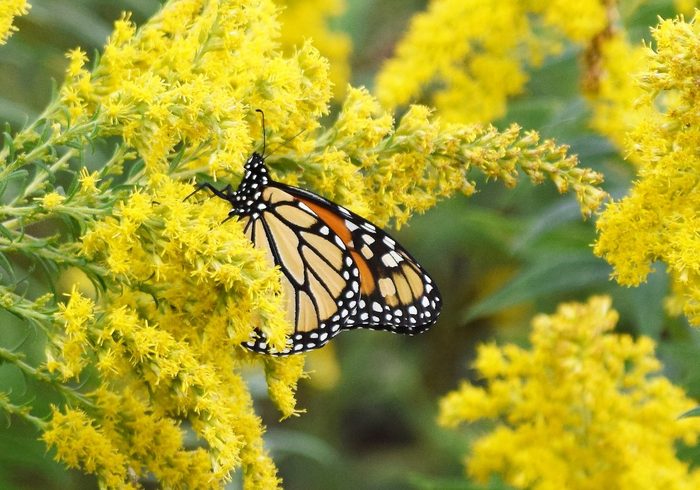
- Ageratum: Light blue to periwinkle; annual
- Anise hyssop (Agastache foeniculum): Light blue to deep blue; tall, upright-branching perennial
- Boneset (Eupatorium perfoliatum): White; perennial
- Caryopteris: Light blue to powder blue; shrub
- Dandelion (Taraxacum officinale): Yellow; perennial
- Gayfeather or Blazing star (Liatris): Pink-purple; perennial
- Goldenrod (Solidago): Yellow; fast-spreading perennial
- Hawkweed (Hieracium): Yellow or red-orange; often grows as a weed but lovely in a casual garden
- Joe Pye weed (Eupatorium purpureum): Mauve or pinkish-purple; bold, large perennial with upright stems of whorled leaves
- Mistflower (Hardy ageratum or Conoclinium coelestinum): Light blue; fast-spreading perennial
- Rabbitbrush (Chrysothamnus): Yellow; drought-tolerant, Western native shrub
- Sedum: Pink to rose, white, yellow; succulent-leaved plants ranging from ground covers to clumping perennials
- Sweet sultan (Centaurea moschata): Yellow, pink, purple, white; annual
- Tassel flower (Emilia coccinea): Vivid red-orange; annual
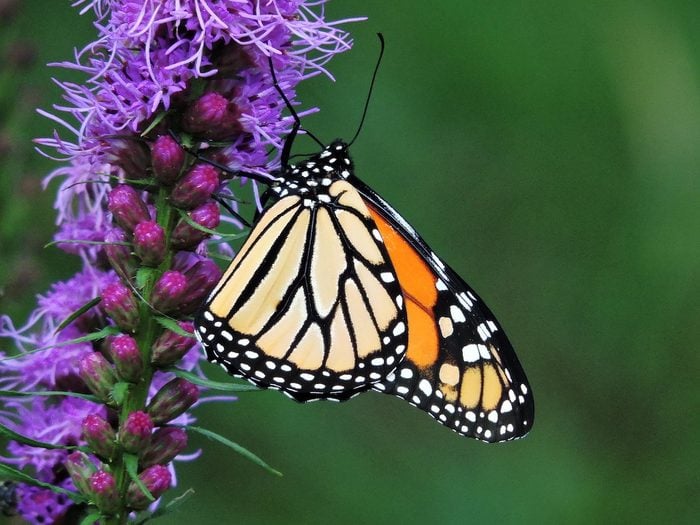
Next, discover the top 10 butterfly host plants to attract pollinators.
The Top Songbirds
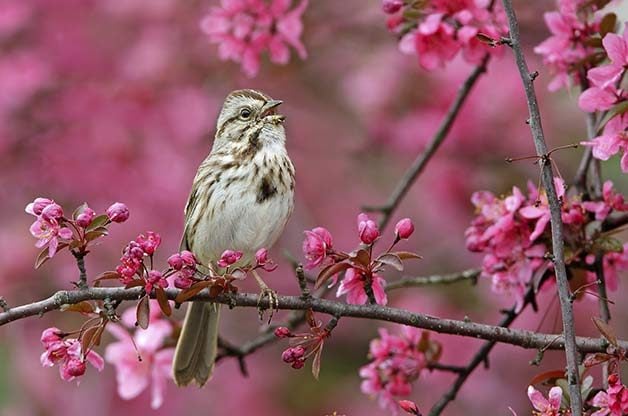
What is the best bird song? How can we choose when there are so many beautiful songbirds in the bird world! And the winner is…the wood thrush. Or the hermit thrush. Or maybe it’s the mockingbird, veery or the house finch. With hundreds of bird songs to choose from, picking the singer who reigns supreme all depends on who’s listening. But whichever bird strikes a special chord in your own heart, this list of soulful songbirds will definitely give you a few new favorites to discover. Here’s some of the best songbirds in America.
Learn how to identifying birds by their song.
Thrushes
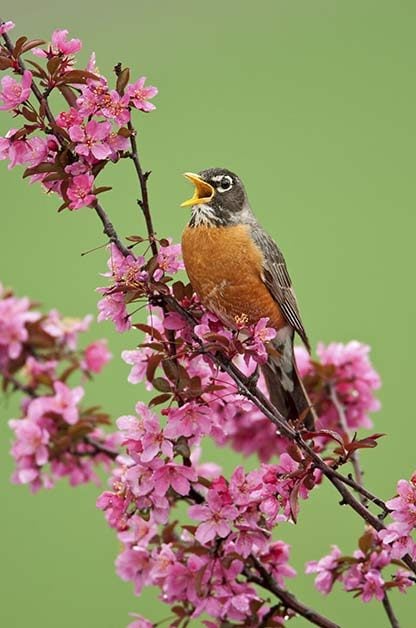
Imagine yourself in a spring wood in the dim light at the end of the day, listening to the poignant song of a wood thrush. Pretty soon, you too may be inspired to write a love letter to this singer, as Thoreau did in his 1852 journal, extolling the wood thrush’s evocation of “the liquid coolness of things drawn from the bottom of springs.” The simple ee-oh-lay followed by a trill is haunting, no doubt, but it’s the twilit surroundings that make it pure magic.
Another thrush with a delightful song is the veery. This bird’s simple song, a whirling, reedy repetition of its own name, is also delivered at dawn and dusk in the dim forest, going straight to the romantic heart of the listener.
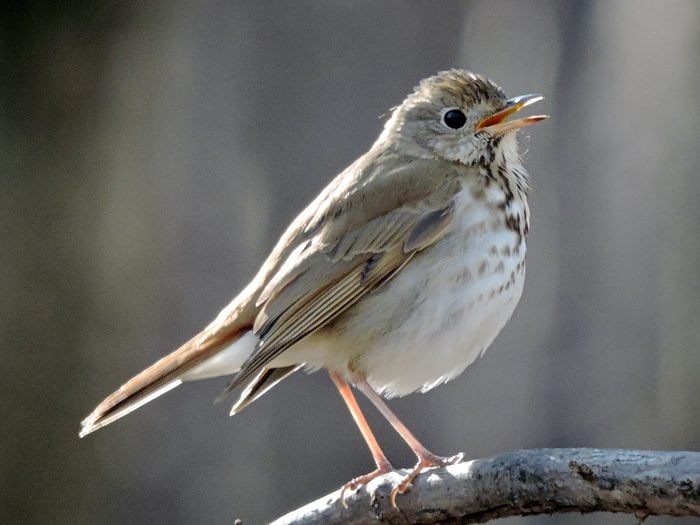
The song of the hermit thrush isn’t nearly as sweet and heart-tugging, but its rapid, liquid melody resonates with our ears because it follows some of our own musical scales, a trait that researchers only confirmed last November after carefully analyzing recordings.
Finally, a bird so common we tend to never give it a second glance: the American robin. Take a few minutes to listen, and you’ll see it shares the musical talents of its thrush family. Wake up early to listen for a robin bird call.
Wrens
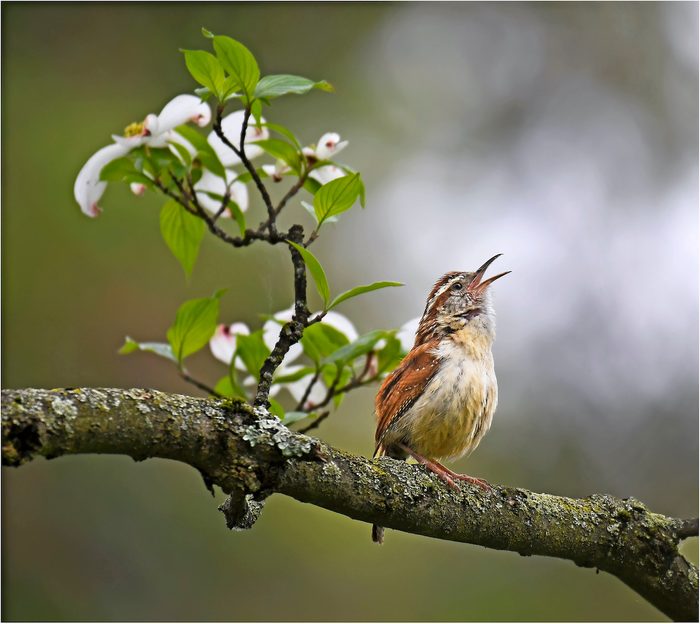
An unstoppable waterfall of notes spills from the throat of the tiny, indefatigable house wren, one of our most beloved backyard birds. Put up a birdhouse with a 1-1/8-inch entrance, and you have a good chance of welcoming a whole family (including baby wrens!). The house wren is the virtuoso, but all wrens have voices that will perk your ears up. Learn what a Carolina wren call sounds like.
Orioles

Loud, clear, whistled songs are the hallmark of these vividly colored birds. Oranges, jelly, sugar water and suet will attract orioles to visit your yard. Learn what a Baltimore oriole song sounds like.
Sparrows and Finches
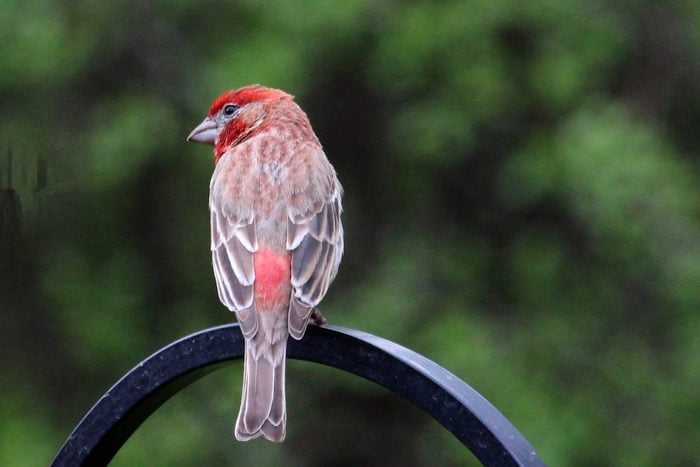
Every one of our native sparrows (more than two dozen species) has a song, and many are sweet and melodic. Listen for the common, brown-streaked song sparrow, which begins singing in late winter. House finches are among the earliest singers, beginning their complicated warbling not long after the turn of the year. These species prefer seeds, so stock up on white proso millet for sparrows, sunflower seeds for finches and nyjer for a treat.
Mimic Thrushes

Northern mockingbirds, gray catbirds and brown thrashers have charming songs, but they can mimic other sounds, too. You’ll hear them singing at dawn, dusk and off and on throughout the day. They’ll sometimes sing at night, too. The mockingbird in particular may take it to extremes, holding forth for hours from the rooftop right over your bed. Learn more about thrasher birds.
Grosbeaks

Less common than other songsters, the rose-breasted, black-headed and blue grosbeaks are all melodic warblers within their nesting ranges or along their spring migration routes. Once a rarity at feeders, they’re becoming more and more frequent visitors. They’ll eagerly eat sunflower seeds, as well as small, soft fruits from bushes or trees.
The most familiar grosbeak is one we don’t usually think of, although its heavy bill says otherwise. It’s the Northern cardinal, one of our most abundant and beautiful backyard singers. Learn what a cardinal’s call sounds like.
Tanagers
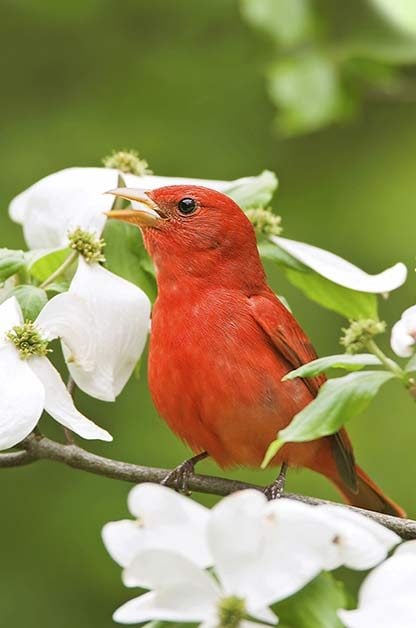
Seeing—or hearing—a tanager is usually a red-letter day because these birds aren’t nearly as abundant as other songbirds. Still, keep your ears open for their long, robinlike songs, especially during spring migration, when they may stop off in any backyard. Some tanager songs have a hoarse quality, suggesting “a robin with a sore throat.”
Discover 8 surprising facts about tanagers.
European Starling

What’s the scorned starling doing among the sweet-voiced songbirds? Well, it’s an incredible singer, too. Best of all, starlings begin singing in winter, just when it feels like spring will never come.
Meet the vireo bird family: sweet summer singers.
Attract More Songbirds to Your Backyard
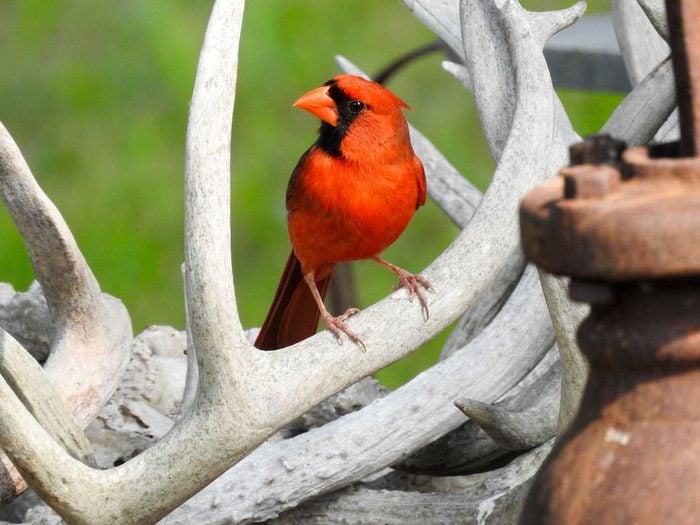
Insects and fruit are the natural menu for most of our finest songsters, including thrushes, orioles, tanagers, mimic thrushes and many grosbeaks. The more trees, shrubs and other native plants in your yard, the more of these birds you’re likely to hear as they forage for insects and other natural food.
Many songbirds are only recently discovering feeders, so stock yours with a variety of offerings: Suet, mealworms, oranges, apples, peeled bananas and grapes are a great start. Don’t hesitate to experiment, either. When I dumped small chunks of dried papaya in the feeder, a gray catbird and a Baltimore oriole took turns snatching them up. Orioles and a few others are famed for having a sweet tooth and will eat jams and jellies or visit an oriole feeder with perches. Finches, buntings, native sparrows and grosbeaks prefer seeds at the feeder. Another must is a bird bath. They’re a big attraction for all songbirds.
What Does a Purple Martin Look Like?
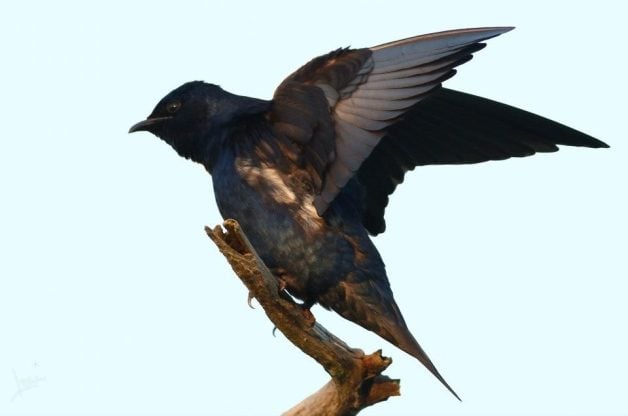
The purple martin is the largest swallow in North America, and arguably the most popular. Males have dark purpleish black feathers all over their bodies. The females are paler in color, with dark heads and tails, and gray or white feathers on their throats and bellies. They measure about 8 inches in length with a wingspan of 18 inches. Young birds look like females but have whiter bellies. All martins have pointed wings and forked tails. That distinctive tail helps them catch flying insects, like dragonflies.
Nest and Eggs
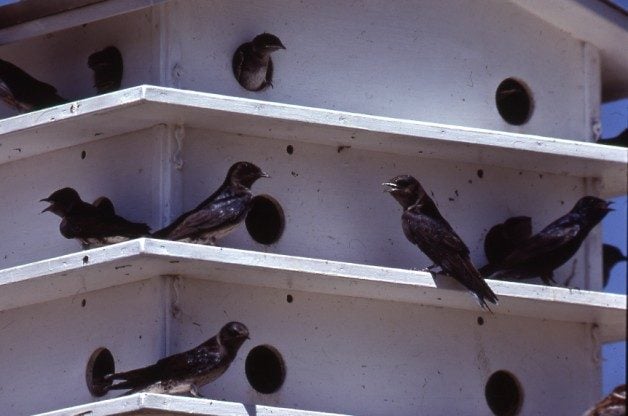
As with many species that breed in North America but migrate to and from the tropics, the first to return are the older males on their way to claim last year’s nesting sites. Females and younger birds arrive later. In the Midwest, the northern part of the range, martins start to arrive as early as March. Then the search for the perfect home begins.
A pair constructs a nest of plant materials before female lays four to five white eggs. Females incubate the eggs for 15 to 16 days. Both adults raise and feed the young, which fledge in about 30 days. The baby birds then beg their parents for food for several more weeks.
The secret to attracting purple martins is to set up multichambered nest boxes near open areas for them to raise their young. Place a purple martin house or several gourd houses high in the air. Inside the martin house, their nest is a cup of grass, leaves, twigs, miscellaneous debris and usually some mud.

Creating a purple martin neighborhood is an old practice. Precolonial Native Americans hung up empty gourds for the birds to use. Today, purple martins in the eastern U.S. nest almost exclusively in birdhouses.
Purple martins nest in colonies of six to eight pairs—well-established colonies can grow into the hundreds.
DID YOU KNOW? Purple martin houses need to be placed in the open and 15 to 20 feet high.
Learn how to turn a gourd into a birdhouse.
What Do Purple Martins Eat?

Violet-hued purple martins are entirely aerial insectivores, so they won’t stop at backyard feeders. They rarely land on the ground. Martins even drink on the wing by flying low over ponds and skimming their bills across the surface. Your best bet is to grow more native plants that attract bugs for them to eat.
Do purple martins eat mosquitoes? Here’s what you should know.
Purple Martin Song

The purple martin’s song is a low-pitched warble. Martins can often be heard calling as they glide above forested areas in an attempt to attract younger adults to the colony.
Bird songs provided by the Cornell Lab of Ornithology.
Learn how to identify and attract a tree swallow.
Range Map and Habitat
Look for these birds in open areas with water nearby. Purple martins are frequent summer visitors in the eastern states, and are rarely spotted out west.
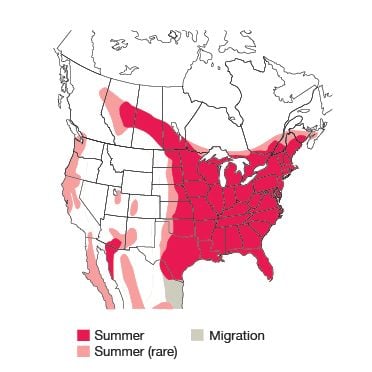
Range maps provided by Kaufman Field Guides, the official field guide of Birds & Blooms.

When fall’s in full swing, porches and gardens across the country are decorated with the November birth flower—chrysanthemums. More commonly known as mums, the November birth flower is one of autumn’s most popular flowers.
Chrysanthemums bloom in a variety of bright colors, making them a decorative focus for gifts—especially for November birthdays and Thanksgiving tables.
Not celebrating a November birthday? Check out our birth flower gift guides for January, February, March, April, May, June, July, August, September, October and December.
What Is the November Birth Flower?

Chrysanthemum, also known as mums, is the official November birth flowers. These popular fall plants come in a variety of vibrant autumn hues like yellow, burgundy, orange, pink, purple and even white.
While there are hundreds of chrysanthemum varieties across the globe, only two basic groups of mums are available for purchase: florist mums and garden mums.
Chrysanthemums are florist mums, which are typically grown and sold as an annual. They’re a beautiful flower to show off during the holiday season and make stunning fall displays, but they won’t survive harsh winter weather. Garden mums tend to be heartier perennials that are planted directly into your garden for enjoyment year after year. Just don’t plant them in the fall.
What Is the Meaning of November’s Birth Flower?

Mums represent friendship, honesty and loyalty. The meaning of chrysanthemums change based on the color of the bloom. White mums symbolize loyalty and honesty; yellow mums represent a broken heart; violet mums are known for get-well wishes; and red mums symbolize love.
Now that you know more about the November birth flower, take a look at these chrysanthemum-inspired gifts. From sustainable tote bags to jewelry these floral gifts are sure to impress everyone on your November birthday list. And they make excellent Thanksgiving host gifts, too!
November Birth Flower Gift Guide
Chrysanthemum T-Shirt

This t-shirt features a botanical illustration of a chrysanthemum, along with the meaning of the November birth flower: pure love and honesty. Not only does it make a beautiful gift, a tree is planted by One Tree Planted for every t-shirt purchased. Choose from three different colors and a variety sizes.
Chrysanthemum Charm Bracelet

This knot-style bangle bracelet includes a delicate charm with a chrysanthemum illustration. The bangle adjusts to the wearer’s wrist size, and three finishes are available: rose gold, silver and gold. Stunning.
Chrysanthemum Scarf

This botanical print scarf featuring a pattern of chrysanthemums is the perfect accessory to any outfit. The wearer can dress it up or dress it down, cherishing it for years to come. Bonus: this scarf comes pre-packaged in a decorative gift box printed with the flower’s name and the associated meanings.
Mum Sweatshirt

Everyone needs a cozy sweatshirt to wear on crisp fall nights, which is why this chrysanthemum sweatshirt is a go-to pick for November birthdays. It’s stylish enough to wear out to brunch or to Friday night sports games. Choose from a variety of colors and sizes.
Chrysanthemum Tote Bag

Not only is this canvas tote bag sustainable and eco-friendly, its a cute accessory. Each bag features an illustration of the November birth flower printed on one side. This tote is ideal for grocery shopping or running everyday errands.
Chrysanthemum Robe

Give the gift of relaxation with this watercolor chrysanthemum robe. It’s pretty enough to wear around the house, and the fabric is made from sustainably sourced, biodegradable material, so you can feel good about where it came from.
Chrysanthemum Tea Towels

This chrysanthemum tea towel is guaranteed to add some sunshine to any kitchen. The unique watercolor design makes it a beautiful gift, and the person on your list will think of you every time they put it on display.
Mum Seeds

If you can’t gift a bouquet of mums, you can gift these mum seeds. Sure, they take a little more TLC, but the growing process is part of the fun. This set includes 400 chrysanthemum seeds in a variety of colors. Tuck them inside a birthday card.
Chrysanthemum Glassware

Help your loved one raise a glass to their birthday with this stemless chrysanthemum wine glass. And if they don’t drink wine, it’s a chic find that can be used to hold any beverage.
Chrysanthemum Necklace

This handmade, heart-shaped necklace is set in clear eco-resin, freezing the beauty of the November birth flower in time. Small, colorful chrysanthemum flowers are preserved in the charm and displayed on a 24 karat gold-plated adjustable chain.
Why Eliminate Chemicals in Your Garden?

Even if you don’t have children or pets, there are plenty of reasons to steer clear of chemicals. For starters, pesticides, fungicides and herbicides don’t just kill pests and weeds—they also kill helpful birds and insects. According to the National Audubon Society, an estimated seven million birds die each year because of exposure to lawn pesticides. These pesticides also come with hidden consequences, like polluting the runoff water that flows into our water systems. A number of lawn pesticides contain carcinogens, which are linked to birth defects, and nervous system, liver and kidney damage. But if we can all agree that eliminating pesticides and herbicides from our home gardens is a great idea, how do we go about doing it? Follow these tips to grow a natural garden.
Learn about the Ruth Stout Method and more tips to garden greener.
How to Grow a Natural Garden
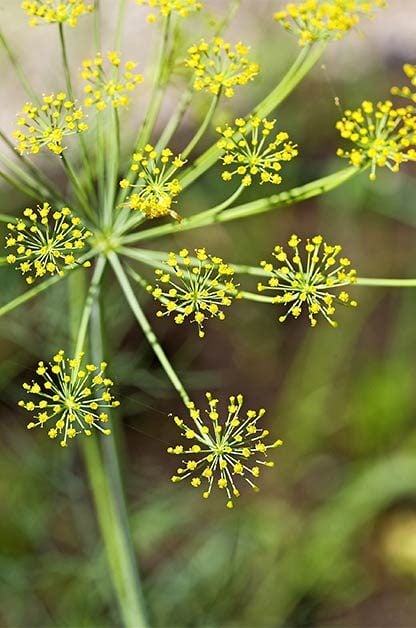
Nurture Healthy Plants
The first line of defense in a pesticide-free garden is healthy plants. Pests prey on weak plants, so to keep them out of your garden, your plants need to be as healthy as possible. Start with the soil. Load it up with as much compost and organic matter as you can. This provides the perfect environment for healthy, strong plants.
“It’s all about developing the soil,” says Calvin Bey, an organic gardening educator from Fayetteville, Arkansas. “My natural method for eliminating insects and disease in the garden is the development of healthy soil, alive with beneficial microbes and containing a balance of minerals.”
Organic mulch will protect your soil and provide a habitat for beneficial predators like ground beetles, centipedes and spiders.
Picking the right plants is important, too. Choose plants that are disease-resistant, native in your area and fit the growing conditions.
“If you grow nutrient-dense produce, the pesticide issue pretty much takes care of itself. When you get started, you might need to use a little diatomaceous earth and BT (Bacillus thuringiensis). These are natural garden products that can help with specific insects,” adds Calvin.
Check out 8 green gift ideas to help pollinators and the Earth.
Invite Helpful Garden Allies
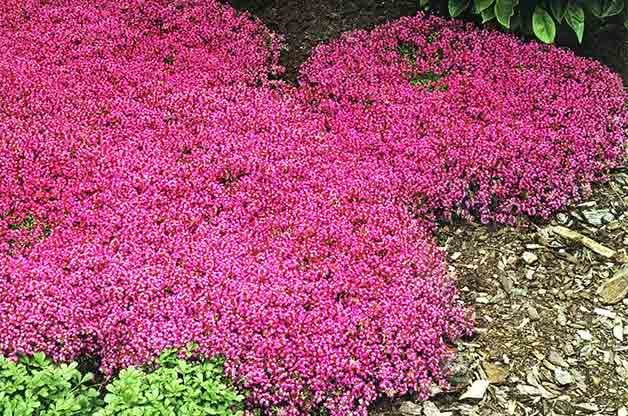
Less than 1 percent of the pest population of a garden can truly be considered pests. Most of these bugs are actually your garden allies, ready to take on the bad bugs. These unsung natural garden heroes include:
Pollinators (bees, butterflies and moths) transfer pollen between the flowers of fruiting plants, fertilizing female flowers, so fruits and seeds develop. They are important to tree crops, berries and other veggie crops.
Parasitic wasps and parasitoids (wasps, ants and sawflies) control garden pests before they become a problem in your garden.
Predators (birds, ladybugs, spiders, damsel bugs, dragonflies, lacewings, ants, ground beetles and praying mantises) feed on garden pests that get out of hand.
To encourage these helpers to visit your garden, you first have to stop using pesticides. These garden friends can be wiped out when pesticides are used.
Next, plant with insects in mind. Choose colorful, flowering plants to attract bees and parasitoid wasps. Grow a variety of plants at different sizes, including shrubby structural plants, plants with lacy foliage and herbs for bees and other pollinators. Don’t be too tidy with your garden design; a more natural garden will provide shelter and nesting spots for birds and other beneficial insects. Allow some plants to go to seed and some herbs to flower such as dill, cilantro, basil, oregano and thyme.
Natural Garden Pest Solutions

If you are looking for a solution to a specific problem, try a less toxic product, like insecticidal soaps or horticultural oils. These are helpful in controlling aphids, caterpillars, crickets, fleas, flies and mites. But don’t use them if bees are present.
To deter slugs, try placing coffee grounds or copper mesh around your plants. Use strong-scented soap like Irish Spring to deter rabbits or deer. Cayenne pepper works for other critters. Take steps to attract birds like robins, wrens, flycatchers and warblers that feast on insects and control pests, and provide plenty of nesting sites with native shrubs. Ask fellow gardeners or your local extension service for other natural methods for controlling a specific pest or disease.
“Often all you need to do is spend time in the garden,” says Erin Riley of the organic garden site, yourhopegarden.com. “‘The best fertilizer is the shadow of the gardener’ is a common and true saying. You might need to pull some weeds or hand-pick some bugs, but time spent in the garden is time well spent.”
Discover 15 ways to conserve water in the garden.
Plants to Attract Beneficial Insects

- Creeping thyme
- Marjoram
- Tarragon
- Rosemary
- Lavender
- Mexican sunflower
- Dill
- Oregano
- Fennel
- Salvia
- Sage
- Yarrow
- Mint
- Catmint
If You See a Wren, What Does it Mean?

If your backyard is within the house wren or Carolina wren range, and you have anything remotely resembling a wren house outside, you’ve likely heard the birds’ bubbly call. Perhaps you even had a wren trying to nest in the clothes on your clothesline (it happens), or, if you were lucky, baby wrens! But to some people, seeing a wren has meaning.
Like spotting a robin, a wren can be a sign of spring. These little brown birds don’t have flashy plumage like summer tanagers or painted buntings, but they’re no less beloved in the backyard. Here, we’ve chatted with our Birds & Blooms field editors about their wren sightings, and what those memories of wrens mean to them.
Wren vs sparrow: What bird are you seeing?
Wren Meaning: Family Memories

“My papa used to make wren houses and hang them in the trees around his garden and home. He loved the house wrens’ cheery song and appearance in spring. I live in my grandparents’ home now. Wrens still love to hang out in our spirea bushes and wake us with their songs each morning!” Jennifer Broadstreet Hess says.
Psst—here’s how to tell the difference between a house wren vs a Carolina wren.
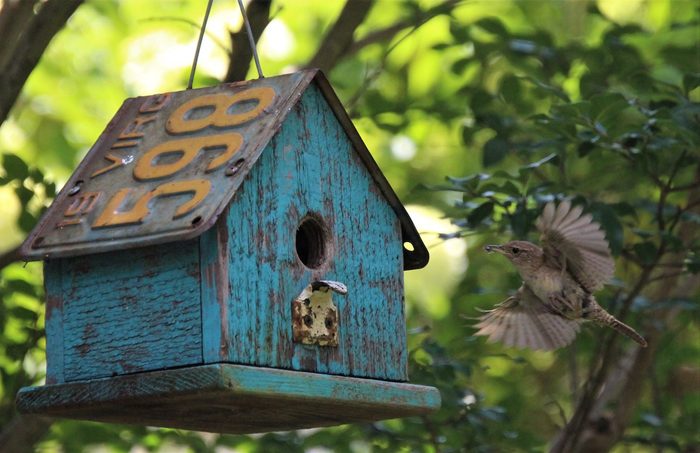
“Wrens nested every year on my grandmother’s porch. Her couch was underneath the large porch window, and we could stand on it to peek inside the nests and watch the eggs hatch. If you sat still, you could watch the parents bring the babies food. When they were bigger, you could see their heads poke out without standing on the couch. My grandmother loved watching her bird families every year and sharing that with us,” Rebecca Williamson says.
Did you know? Cardinal sightings are also significant to many bird lovers.
Wren Meaning: More Sweet Stories
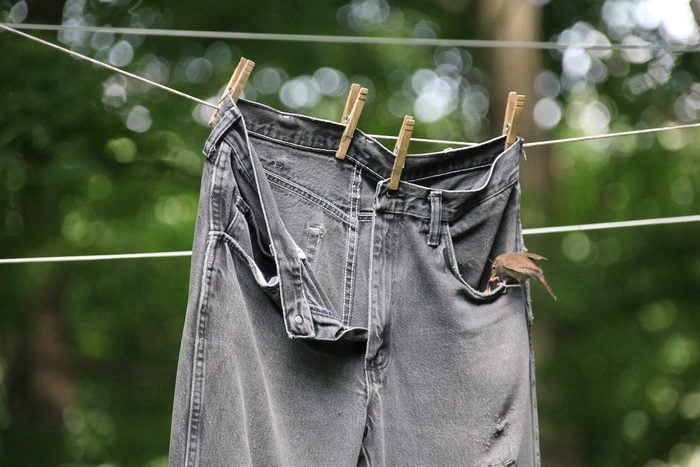
“With a melodious song like no other and a feisty spirit, the house wren was the bird that first won my heart. My mother affectionately called them ‘Jenny wrens.’ Growing up, we had teapot birdhouses with small openings to accommodate these busy little fliers. Each spring we watched as they worked tirelessly to build stick nests. I have both house wrens and Carolina wrens nesting in my yard now. When I see them, I can’t help but remember the time one started to build a nest in my son’s jeans that were hanging on the clothesline. He thought I was being silly, putting sticks in his pants. I folded the nest up with the laundry!” Boni Harrington Trombetta says.
Find out what wrens eat and how to attract them.
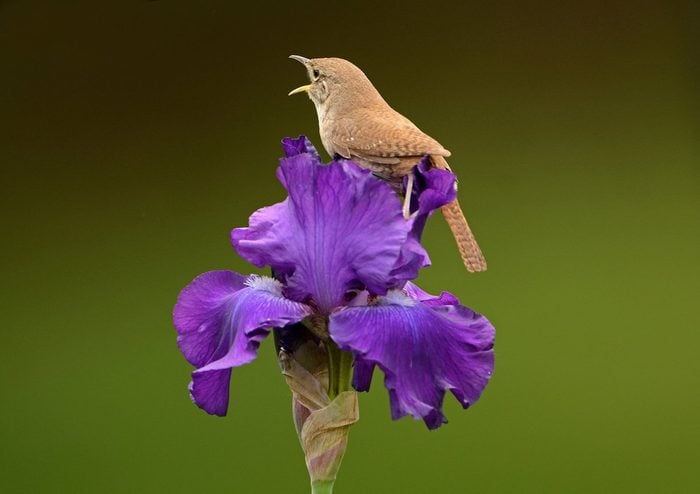
“Carolina wrens have been nesting at our house for 19 years, even before we turned the backyard into a wildlife garden. We rehydrate mealworms to help the early feeding of the babies. When they start taking chopped unsalted peanuts, we know the babies will be fledging soon. One year, the parents were darting around and sounding the alarm call. We found and relocated a yellow rat snake that was getting too close to their nest. Another year, after the babies had fledged, the parents brought the baby wrens to the garden, sat them down underneath the chair I was reading in as if to say, ‘You kids behave, I’ll be right back,’ and just like that, I became the babysitter. The parents came back in 15 minutes, chattered a ‘thank you, let’s go,’ and back into the bushes they went. I feel so blessed for their trust,” DS Damm says.
Next, enjoy delightful pictures of wrens.
Listen to a Carolina Wren Call

Carolina wrens are often heard, not seen. The distinctive ‘teakettle, teakettle, teakettle’ (or ‘germany, germany germany’ or ‘tweedle, tweedle, tweedle’) Carolina wren call rings out through forested areas and wooded backyards in the eastern U.S. Their voices can carry quite a distance. These wrens serenade many birders, singing their verses from perches around the neighborhood.
Bird songs provided by the Cornell Lab of Ornithology.
Learn how to identify a Bewick’s wren and a cactus wren.
This wren species is quite attractive with buff to cinnamon colored plumage, a bold white eye stripe, long and down-curved bill, white throat. More often than not, their tails are cocked up in the air, giving a good view of the distinctive horizontal bars underneath.
Birders love Carolina wrens. The species was even named of Birds & Blooms magazine’s Most Wanted Birds.
House wren vs Carolina wren: Learn how to tell the difference.

My home in Colorado is west of their range. But several Carolina wrens once ventured to a wooded area less than a quarter mile from my house. They stayed for several summers and at least one winter. Apparently this location did not meet their needs, as I haven’t seen them for a few years. I used to enjoy walking on the local trail through there and hearing them sing. I even heard them sing while I was working in my yard one time.
Now I have to be content with hearing them, and spotting them sometimes, when I travel further east. I understand that Carolina wrens are attracted to suet feeders and peanut feeders in backyards. Offer these foods if you want to attract them. You can also welcome nesting wrens to a wren bird house.
Next, don’t miss these adorable baby wren photos.
On This Page
Suet Feeder

You can find many different types of suet feeders. This style of feeder has the suet cage attached to a vertical wooden platform, giving woodpeckers a place to prop with their tails. A suet bird feeder will also attract nuthatches, chickadees, wrens and jays. Here’s how to make your own suet.
Check out the best sunflower seed bird feeders for your yard
.
Peanut Feeder
Peanut feeders are usually shaped like a tube, which can be filled with out-of-shell or in-shell peanuts. Here’s how to make a DIY peanut bird feeder. But you can also find them in round, wreath shapes. These types of bird feeders have large holes, so the birds (and sometimes squirrels) have to work to get peanuts out. Blue jays, nuthatches, tufted titmice and woodpeckers particularly love peanut feeders. Want to see birds up close? Try a window bird feeder!
Oriole Fruit Feeder
To attract orioles, tanagers, grosbeaks and catbirds, look for fruit feeders that hold oranges, grape jelly and apples. These are great feeders to experiment with, especially in spring and fall, when you’ll see the most migrants. Don’t miss the best-selling bird feeders of 2022.

Sugar Water Feeder
Sugar water feeders are typically found in a few standard shapes, including glass bottle, tube and round dish. Whatever shape you choose, this type of bird feeder will be a magnet for those glorious little flyers we call hummingbirds. Here’s how to make your own sugar water. Also look for orange-colored oriole feeders.
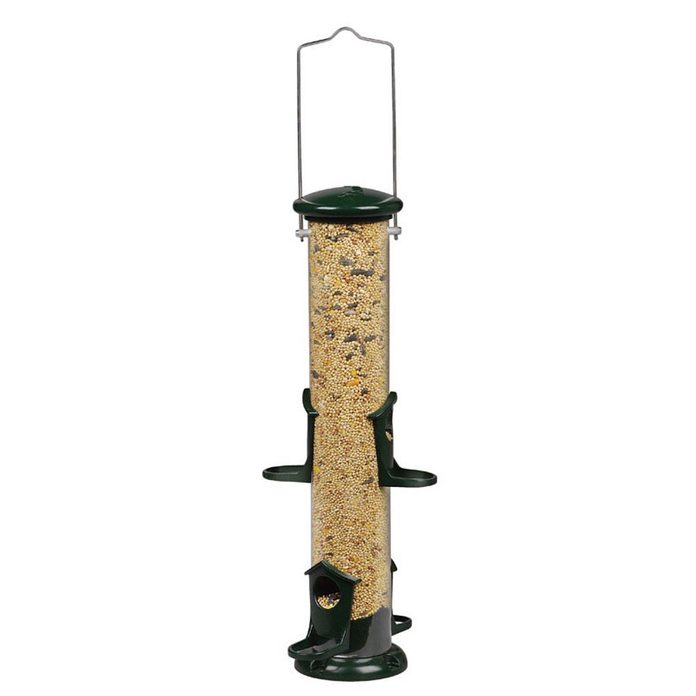
Tube Bird Feeder
Fill tube feeders with sunflower seed or safflower seed to attract many birds, including Northern cardinals, tufted titmice, house finches, chickadees, and grosbeaks. To deter squirrels and bully birds like grackles, look for weight-sensitive tube feeders that close off seed access.

Nyjer Finch Feeder
Often a tube shaped, nyjer feeders hold the special tiny black thistle seed that American goldfinches love. Some types of nyjer bird feeders are a simple mesh sock, while others are made with metal mesh or solid plastic. You can even get nyjer feeders that are several feet long, holding dozens of goldfinches at a time. Check out more of the best finch feeders to serve thistle seed.

Tray or Platform Feeder
Tray or platform feeders can either hang from a hook or sit on your deck or the ground. In both cases, the feeding surface is completely open, so birds have plenty of space to land and eat. Tray feeders are often used to attract larger birds like mourning doves and ground-feeding birds like dark-eyed juncos. Look for feeders with holes or mesh on the bottom to allow for drainage. Love cardinals? We found the best cardinal bird feeders and birdseed.
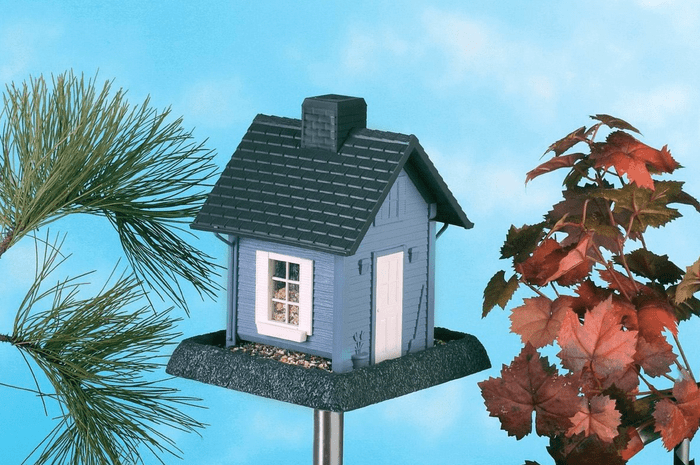
Hopper Bird Feeder
The classic hopper feeder is usually covered with a roof and enclosed on all four sides. It’s common to find these types of bird feeders in the shape of a house or a barn. Sometimes you can even find hopper feeders with suet cake holders on either end. While they typically don’t deter squirrels, hopper feeders do protect seed from rain and snow. Larger birds such as woodpeckers, grosbeaks and mourning doves frequently visit them.
Find out how (and how often) to clean bird feeders.
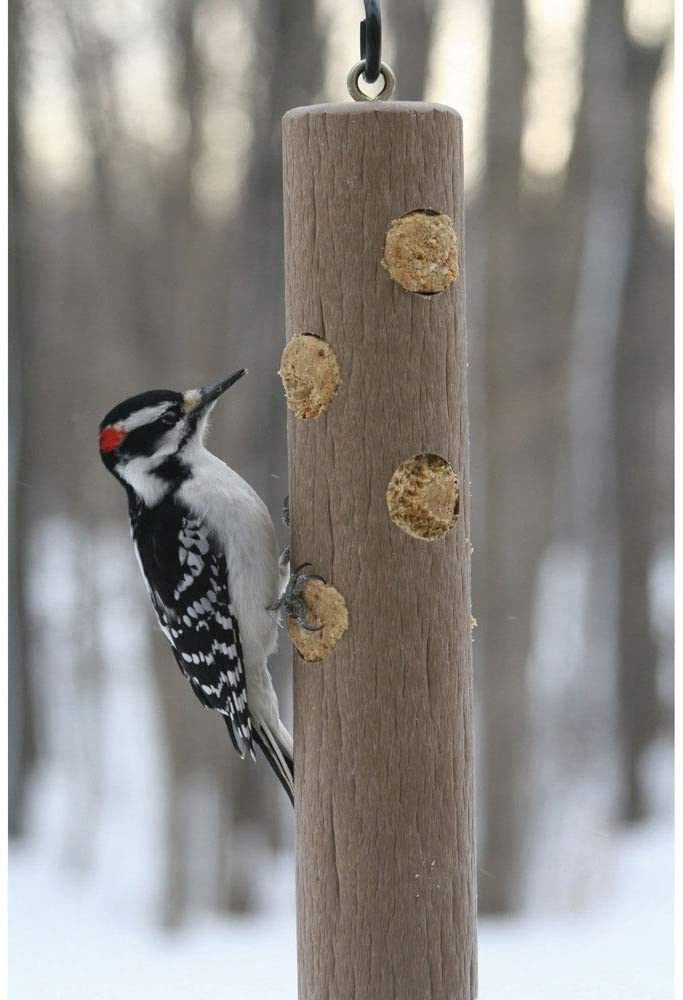
Log Feeder
If you want a thrifty, DIY project, take an old log and drill a few holes in the side. These holes are perfect for stuffing full of suet or peanut butter for the birds. Plus, the log feeder gives woodpeckers, blue jays and nuthatches a built-in perch.
We found large capacity bird feeders to feed a crowd.

Mealworm Bluebird Feeder
To attract bluebirds and other insect-eating birds like thrushes and wrens, offer live mealworms in bluebird feeder. Try a small glass dish or a domed feeder. Here’s our guide to feeding mealworms.
